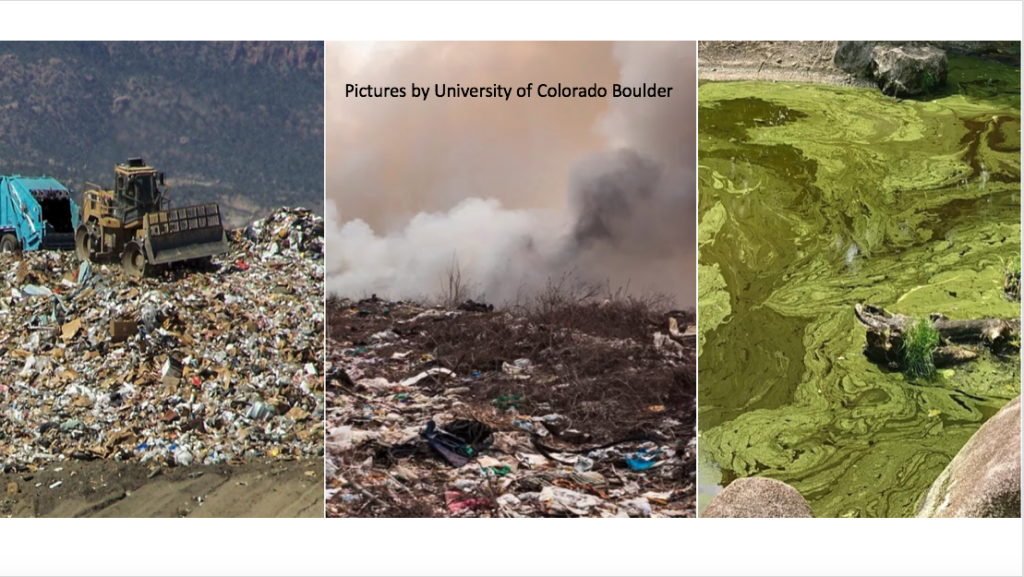Published: April 15, 2021 • By Kayla Vasarhelyi

The United States has over 3,000 active landfills and 10,000 closed landfills. Landfills are necessary for the proper disposal of solid waste. They reduce the amount of waste that makes it into the environment, help to prevent disease transmission, and keep communities clean. However, landfills still have significant environmental and social impact. While landfills are a societal necessity, there are practices that can reduce the reliance on landfills and decrease their effects on the biosphere.
Environmental Impact of Landfills
-
- The most pressing environmental concern regarding landfills is their release of methane gas. As the organic mass in landfills decompose methane gas is released. Methane is 84 times more effective at absorbing the sun’s heat than carbon dioxide, making it one of the most potent greenhouse gases and a huge contributor to climate change.
-
- Along with methane, landfills also produce carbon dioxide and water vapor, and trace amounts of oxygen, nitrogen, hydrogen, and non methane organic compounds. These gases can also contribute to climate change and create smog if left uncontrolled.
-
- The creation of landfills typically means destroying natural habitats for wildlife. The average landfill size is 600 acres. With over 3,000 active landfills in the United States, as much as 1,800,000 acres of habitat have been lost.
-
- While landfills are required to have plastic or clay lining by federal regulation, these liners tend to have leaks. This can result in leachate, a liquid produced by landfill sites, contaminating nearby water sources, further damaging ecosystems.
-
- Leachate can contain high levels of ammonia. When ammonia makes its way into ecosystems it is nitrified to produce nitrate. This nitrate can then cause eutrophication, or a lack of oxygen due to increased growth of plant life, in nearby water sources. Eutrophication creates “dead zones” where animals cannot survive due to lack of oxygen. Along with ammonia, leachate contains toxins such as mercury due to the presence of hazardous materials in landfills.
Social Impact of Landfills
-
- Emissions from landfills pose a threat to the health of those who live and work around landfills. A study in New York found that there is a 12% increased risk of congenital malformations in children born to families that lived within a mile of a hazardous waste landfill site.
-
- Large landfills, on average, decrease the value of the land adjacent to it by 12.9%. Smaller landfills depress land values less, with around a 2.5% reduction, but still have an impact.
-
- Landfills bring hazards such as odor, smoke, noise, bugs, and water supply contamination.
-
- Minority and low-income areas are more likely to find themselves home to landfills and hazardous waste sites. These areas have fewer resources to oppose the placement of these facilities. This makes them an easier target for landfill placement than higher income areas.
How to avoid landfills
-
- Recycle! Every year the amount of waste that avoids the landfill increases due to recycling. Continuing to recycle will keep plastic and other materials out of the biosphere and put them to further use!
-
- Avoid single-use plastics. Check out this article on single-use plastics and how to avoid them from the CU Zero Waste team here.
-
- Compost! Landfills lack the oxygen that compostable items need to fully decompose. By putting biodegradable items into the compost instead of the trash, huge amounts of waste can avoid the landfill.
Landfills help to keep our communities clean, but they also pose serious threats to the health of our environment. Working towards living a zero waste lifestyle will help to reduce our reliance on landfills, their impact on the environment, and their impact on human health and well-being.
To read the article on the University of Colorado Boulder’s website click here.




